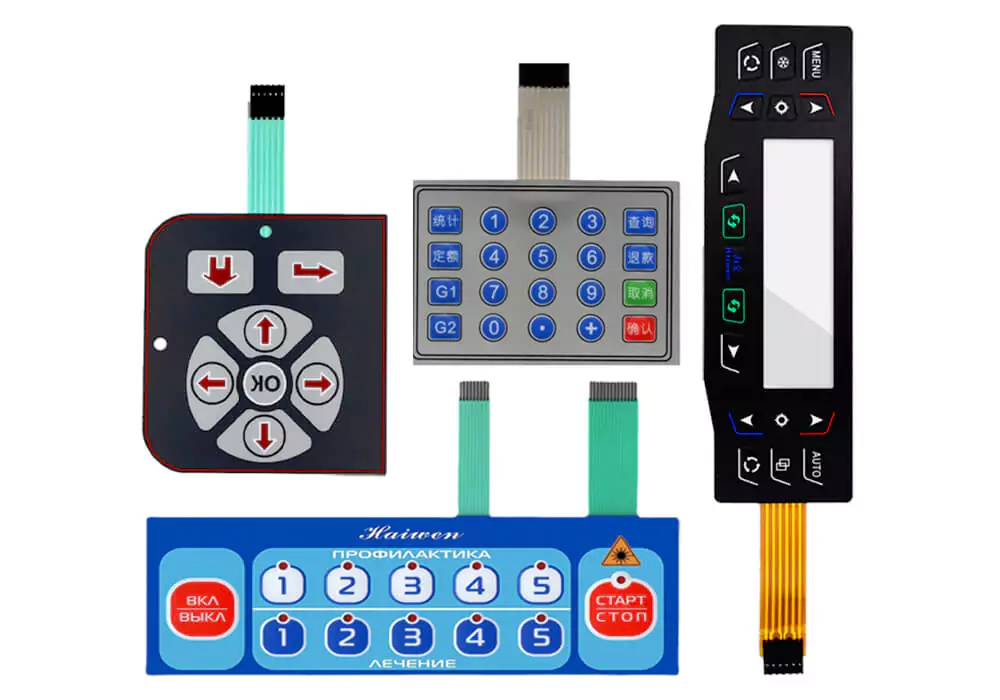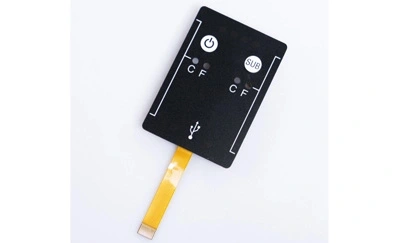How membrane switch is enhancing user interaction in medical devices
Wiki Article
The Production Refine Behind Membrane Switch Over: What You Required to Know
The production process behind membrane layer switches combines cautious layout, product option, and quality assurance. It starts with recognizing the intricacies of membrane layer switch design and progresses through numerous stages, including product options and printing techniques. Each phase plays a crucial duty in making certain performance and sturdiness. The complexities of layer building and the extensive screening standards might reveal understandings that are not promptly evident. What lies past these fundamental elements?Recognizing Membrane Switch Over Design
Membrane layer buttons may appear basic at initial look, their design involves elaborate factors to consider that guarantee performance and resilience. The layout procedure begins with a complete understanding of customer needs, consisting of the interface's desired application and environmental variables. Functional designs is an essential component, as the layout should help with convenience of usage while making sure that responsive responses meets individual expectations.Moreover, the layering of components, such as visuals overlays, sticky layers, and conductive traces, need to be specifically engineered. membrane switch. This layered arrangement not only influences the button's responsiveness however also impacts its long life. Focus is provided to the sealing techniques utilized to protect against moisture and dust, which can endanger efficiency. Additionally, layout considerations reach aesthetics, where color pattern and visual clearness improve individual experience. Eventually, the design of membrane changes balances capability, user experience, and durability, ensuring that they satisfy the demands of different applications efficientlyProducts Used in Membrane Layer Switch Over Production
When selecting products for membrane switch production, it is necessary to ponder both performance and resilience. The primary products consist of polyester and polycarbonate movies, which supply flexibility and stamina. These movies are often covered with sticky to ensure appropriate bonding to substrates. Conductive inks, usually made up of silver or carbon, are critical for creating electrical links within the switch, allowing for trustworthy operation.Additionally, a safety layer, such as a difficult coat, is regularly related to enhance scratch resistance and long life. The choice of backing product, such as acrylic or foam, can considerably influence the button's responsive feel and total individual experience. Numerous environmental aspects, consisting of temperature level and humidity, must lead material selection to guarantee peak performance in specific applications. Ultimately, the right combination of products adds to the membrane button's capability and lifespan, making educated choices crucial for manufacturers.The Printing Process: Creating Video and Text
The printing process in membrane layer switch production plays a substantial role in creating high-grade graphics and message. Numerous visuals design techniques are used to guarantee aesthetic appeal and functionality, while cautious ink selection techniques are important for toughness and performance. Comprehending these components is basic for achieving best cause membrane switch layout.Graphic Style Techniques
Graphic layout methods play a necessary function in the printing process of membrane layer switches, as they specify exactly how graphics and message will ultimately show up on the end product. Efficient graphic style involves the tactical use fonts, designs, and colors to improve readability and visual charm. Designers usually make use of vector graphics for scalability, making certain that images stay sharp at various sizes. Furthermore, attention to comparison and placement is crucial, as it affects user interaction and aesthetic top quality. The incorporation of branding elements, such as logo designs, need to be handled with care to keep brand name integrity. Generally, thoughtful graphic design methods add substantially to the functionality and attractiveness of membrane switches, affecting customer experience and item performance.Ink Selection Approaches
Choosing the appropriate ink is essential for accomplishing the preferred visual top quality and resilience in membrane button production. Various ink types are utilized, consisting of solvent-based, water-based, and UV-curable inks. Each type offers distinct qualities, such as attachment, versatility, and resistance to environmental elements. Solvent-based inks are typically favored for their sturdiness and dynamic shades, while water-based inks are more eco-friendly yet may have limitations in attachment. UV-curable inks give fast healing and robust performance. Furthermore, color matching strategies assure that the chosen inks straighten with design specs. Eventually, the option of ink need to think about variables such as application method, substrate compatibility, and end-use demands to accomplish remarkable outcomes in membrane button graphics and text.Layer Building And Construction and Assembly

Material Selection Process
A cautious selection of products is necessary in the manufacturing procedure of membrane layer buttons, as it directly influences performance and longevity. The primary materials utilized include polyester, polycarbonate, and numerous conductive inks. Polyester is typically preferred for its exceptional resistance to try this website chemicals and abrasion, making it ideal for harsh atmospheres. Polycarbonate, on the various other hand, offers exceptional clearness and effect resistance, which is valuable for applications requiring presence and effectiveness. Conductive inks, generally made up of silver or carbon, are vital for developing trustworthy electrical paths. In addition, the selection of adhesive products impacts the general stability of the button - membrane switch. Reviewing factors such as ecological direct exposure, tactile responses, and visual needs overviews producers in selecting the very best materials for their specific applicationsLayer Adhesion Methods
Sticking layers in membrane switch construction is a crucial process that assures capability and longevity. Various attachment techniques are utilized to protect excellent bonding in between layers, which usually include using adhesives, warmth, and stress. Pressure-sensitive adhesives (PSAs) are typically made use of for their simplicity of application and instant bonding abilities. Furthermore, thermal bonding strategies can be applied, where heat is utilized to turn on adhesive residential or commercial properties, protecting a strong bond. The option of attachment approach largely depends on the materials involved and the particular application requirements of the membrane layer button. Appropriate positioning and uniform application of adhesives are vital to protect against problems, safeguarding the switch operates properly throughout its intended life expectancy.Quality Assurance Measures
Assuring quality assurance during the layer building and construction and setting up of membrane layer switches is necessary for preserving performance and reliability. This procedure typically includes several vital measures, consisting of thorough evaluations at each stage of manufacturing. Suppliers important site utilize advanced testing techniques, such as peel examinations and bond assessments, to validate the integrity of layer bonds. Furthermore, aesthetic assessments are carried out to identify any problems in printing or product variances. Ecological problems, such as temperature and humidity, are meticulously kept an eye on to assure suitable treating and bond. Regular calibration of equipment assists keep specific production standards. By applying these quality assurance steps, makers can substantially lower the danger of product failing, guaranteeing that the final membrane changes fulfill the called for requirements and customer assumptions.Checking and Quality Assurance Measures

Developments in Membrane Change Technology
As advancements in technology continue to develop, membrane switches are taking advantage of cutting-edge advancements that enhance their performance and customer experience. One noteworthy have a peek at this site technology is the assimilation of capacitive touch modern technology, which permits even more responsive and instinctive individual interfaces. This change not just boosts aesthetics however additionally decreases mechanical deterioration, expanding the lifespan of the switches.Additionally, advancements in visuals overlay products have actually brought about improved toughness and resistance to environmental elements such as dampness and UV light. These products currently use boosted quality and brightness, additional raising the visual appeal.Furthermore, the incorporation of wise innovation is transforming membrane changes right into interactive control board, allowing connectivity with IoT devices. This connection fosters a smooth customer experience, leading the way for applications in different industries, from healthcare to customer electronic devices. Jointly, these innovations placement membrane layer switches as important components in modern device design.Frequently Asked Concerns
Just how Lengthy Does the Membrane Layer Change Production Refine Take?
The period of the membrane switch production process can vary significantly. Elements such as complexity, products made use of, and manufacturing volume impact timelines, with normal manufacturing ranging from a few days to a number of weeks for conclusion.What Are the Typical Applications for Membrane Layer Switches?
Membrane switches are typically used in various markets, consisting of auto controls, home devices, medical tools, and customer electronic devices (membrane switch). Their convenience and toughness make them optimal for applications requiring straightforward user interfaces and reliable efficiency in varied environmentsCan Membrane Layer Switches Be Custom-made for Specific Needs?

What Is the Life expectancy of a Regular Membrane Switch Over?
The life-span of a common membrane layer switch differs, however typically, it varies from 1 to 5 million cycles. Factors such as use, environment, and material quality significantly influence durability and total performance in time.

Are Membrane Switches Over Ecologically Friendly?
The ecological friendliness of membrane layer changes varies. Some products made use of might not be recyclable, while others can be environmentally friendly. The total influence depends upon manufacturing techniques and products, demanding careful consideration during choice and disposal. The manufacturing process behind membrane layer switches over combines mindful style, product choice, and high quality control. It starts with recognizing the ins and outs of membrane button layout and proceeds through numerous stages, including product selections and printing methods. When picking materials for membrane layer button manufacturing, it is essential to consider both performance and sturdiness. A mindful option of materials is crucial in the manufacturing procedure of membrane layer switches, as it straight affects performance and durability. The choice of attachment technique mostly depends on the materials included and the specific application demands of the membrane button.Report this wiki page